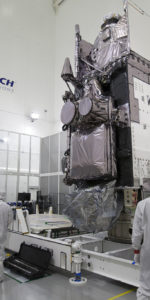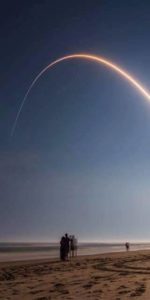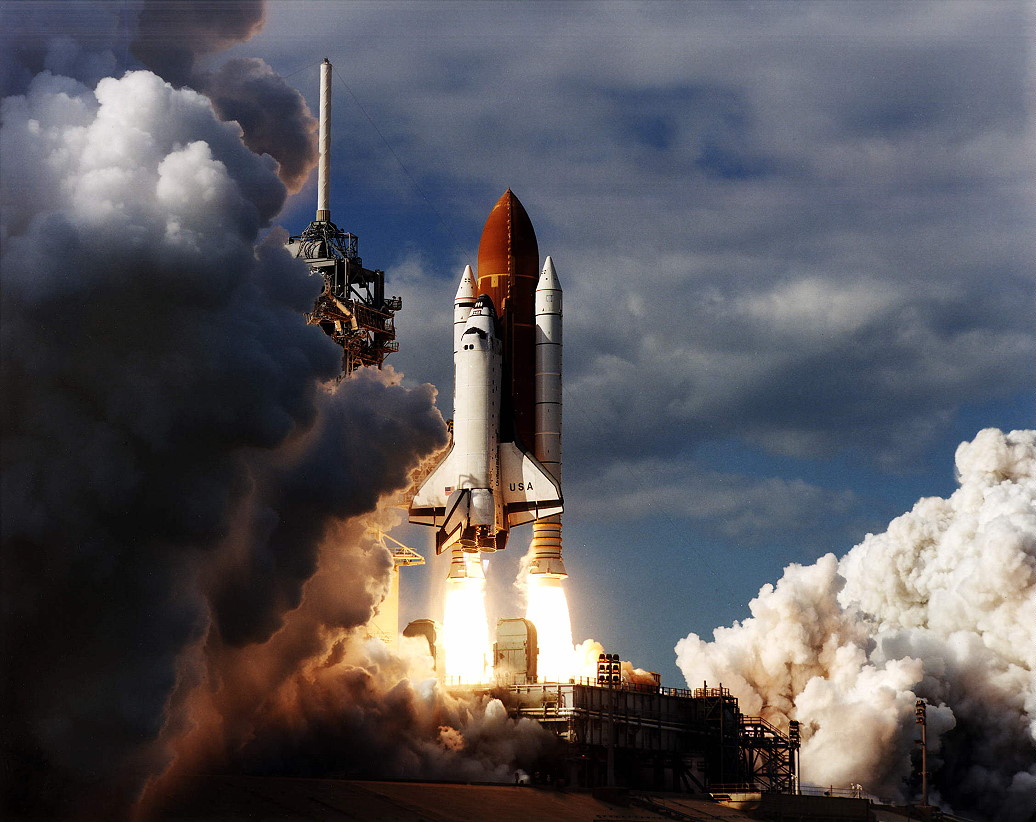
Twenty years ago, today, on 19 November 1996, the longest space shuttle mission in history got underway with the spectacular liftoff of Columbia from Pad 39B at the Kennedy Space Center (KSC) in Florida. During almost 18 days in orbit, the STS-80 crew—Commander Ken Cockrell, Pilot Kent Rominger, and Mission Specialists Tammy Jernigan, Story Musgrave, and Tom Jones—simultaneously deployed and retrieved two separate spacecraft, supported a wide range of scientific and medical experiments, and narrowly missed out on performing a pair of critical EVAs to prepare for International Space Station (ISS) operations. In the words of Cockrell, STS-80 offered nothing less than a “warm-up” for the ISS era. And, indeed, four of the five members of Columbia’s crew would go on to assemble the fledgling station, later in their respective careers.
However, STS-80 met with significant delay in the fall of 1996. Originally scheduled to launch on 31 October, field-joint damage sustained by the Solid Rocket Boosters (SRBs) on STS-78 in June—caused by a new-specification adhesive and cleansing fluid—and the ravages of Hurricane Fran, together with concerns about the fracture characteristics of the shuttle’s aging flight deck windows and other problems, ultimately pushed Cockrell’s crew’s mission back to the second half of November. At length, the launch was targeted for the 19th. At the white room on Pad 39B, the crew were checked out in their pumpkin-orange Launch and Entry Suits (LES) and afforded the opportunity for a spot of banter and a few final words. Cockrell waved to the cameras, whilst Musgrave shook hands with the closeout crew and embraced Jernigan, before boarding Columbia. Jones, serving as the flight engineer, was the last to climb into the shuttle. Shortly before doing so, he held up a home-made placard dedicated to his wife and children: “Liz, Annie, Bryce, I Love You, Be Back Soon!”
A temporary halt in the countdown was called at T-31 seconds, due to a tiny hydrogen leak in Columbia’s aft compartment. Hydrogen propellant leaks can be potentially disastrous; the launch control team took a couple of minutes to gage the leak levels. Jones recalled: “We all thought we’d scrubbed for the day. Hydrogen? We were done. We listened in disappointment to the launch controllers discussing how much hydrogen was leaking into the aft compartment. After a couple of minutes, in laconic, technical tones, two propulsion controllers advised the launch director that the leak rate was stable, and they recommended that ‘we proceed.’ With that, the launch director directed that ‘we pick up the count on my mark: 3, 2, 1, and mark!’ On Columbia’s flight deck, four pairs of eyes watched in disbelief as the clock counted down through 30 seconds. Shocked, we got our heads back into launch mode and tensed for liftoff.”
The shuttle roared aloft at 2:55 p.m. EST, producing a rather unusual optical characteristic and it speared through the low atmosphere. Long-range tracking cameras revealed what appeared to be a “fire” between the two SRBs. It was left largely unmentioned in the post-launch press conference, and NASA spokesman Doug Ward noted that it was nothing unusual, but merely a natural phenomenon caused by the reduced-strength airstream acting upon the booster exhausts. A little under nine minutes into the flight, Cockrell’s crew reached orbit and photographed the jettisoned External Tank (ET), but noticed no evidence of damage to their spacecraft. The stage was set for what they expected to be almost 16 days of orbital operations. Little could they have expected that they would remain in space for much longer, on a mission with many unexpected twists and turns.
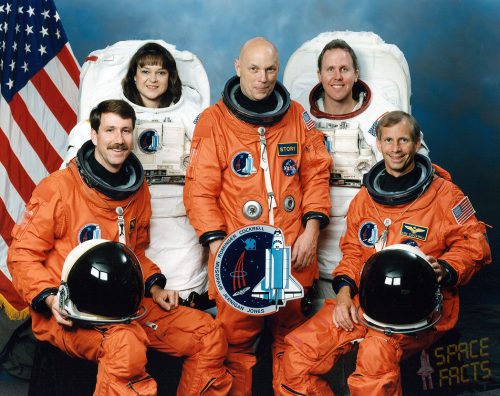
The first major objective was the deployment of ORFEUS-SPAS-2, a mouthful of an acronym, which identified the Orbiting and Retrievable Far and Extreme Ultraviolet Spectrometer, accommodated on a Shuttle Pallet Satellite. Flying for the second time, after an inaugural mission in September 1993, it was a co-operative venture between NASA and the Deutsche Agentur für Raumfahrtangelegenheiten (DARA), the German Aerospace Agency. ORFEUS consisted of a 4-foot-diameter (1.2-meter) telescope, designed to explore very hot and very cold matter in the Universe at far-ultraviolet (90-125 nm) and extreme-ultraviolet (40-90 nm) wavelengths. Virtually invisible to ground-based observers, this region of the electromagnetic spectrum carries the highest density of spectral lines (especially from various states of hydrogen and helium) which are emitted or absorbed by matter of greatly differing temperatures. Combined with an Interstellar Medium Absorption Profile Spectrograph (IMAPS), ORFEUS-SPAS-2 was expected to offer insight into the life-cycles of celestial sources, including white dwarfs, supernova remnants, active galactic nuclei, and star-forming clouds of gas and dust.
At 11:11 p.m. EST on 19 November 1996, a little more than seven hours after launch, Jernigan and Jones released the satellite from Columbia’s Remote Manipulator System (RMS) mechanical arm. The deployment had met with slight delay, due to an extended, ground-directed checkout on the end of the arm, but within three hours ORFEUS-SPAS-2’s aperture door opened and was ready for 14 days of autonomous operations. By the evening of 20 November, Columbia was “leading” the satellite by about 33 miles (53 km), with Cockrell and Rominger overseeing a series of station-keeping maneuvers to provide accurate radar “fixes” on their target. Over several days, the pilots maneuvered closer, and farther away, from the satellite in a comfortable, loose formation.
This was not the first time that such rendezvous exercises had been accomplished, for the shuttle program had a long history of such activity. In fact, the German-built SPAS had been the first payload to be released into space and subsequently retrieved by the shuttle, on the STS-7 mission in June 1983. Since then, it had also supported a Department of Defense experiment on STS-39 and been upgraded into its 7,000-pound (3,150 kg) “ASTRO-SPAS” configuration—powered by lithium-sulfate batteries and afforded highly precise attitude-control functions—which allowed it to remain in autonomous free-flight for much longer than its predecessor.
However, what was occurring for the very first time on STS-80 was deployment and retrieval operations with two separate satellites, simultaneously. A year earlier, Cockrell had piloted STS-69, which deployed and retrieved the Wake Shield Facility on its second flight, together with a solar physics platform named “SPARTAN,” but in that case the first satellite had been retrieved before the second one was deployed. On STS-80, by contrast, the Wake Shield would make its third orbital flight and would be released into space to fly an unusual, multi-day ballet with both ORFEUS-SPAS-2 and the shuttle.
Deployment of the saucer-shaped Wake Shield got underway on 22 November 1996, about three days into the mission. The events leading up to its release from Columbia were indicative of its nature: for the 11.8-foot-diameter (3.6-meter) Wake Shield was tasked with “growing” thin and extremely pure semiconducting films in the ultra-vacuum environment left in the satellite’s wake as it traveled through space. In order to set up the contamination-free conditions for this lab work, Jones robotically detached the Wake Shield from its berth and positioned it over the side of the shuttle’s payload bay for 2.5 hours. By thus facing the film-growing wake side into the “slipstream” of reactive atomic oxygen, the Wake Shield’s surface would be scoured of interfering compounds, ahead of deployment and operations.
Further tests were conducted to check out the Wake Shield’s thrusters and automatic data-acquisition and control systems. The first “deployment window,” when Jones would actually release the satellite from the end of the RMS, was planned during a 41-minute period which opened at 8:06 p.m. EST. After a slight delay, he completed released the Wake Shield at 8:38 p.m.; once floating free, the Wake Shield team ran some further checks on the attitude control system. However, orbital dynamics during that 30-45 minutes brought the Wake Shield uncomfortably close to Columbia as the satellite drifted over the flight deck; the crew got an eyeful of Wake Shield as it glided forward over the flight deck’s top windows, skimming by a bare 2 feet (6o cm) away. The cold-gas nitrogen thruster fired for 19 minutes to finally achieve a good separation distance from Columbia. It was targeted to remain in free flight for about three days. And for the first time in history, two large satellites simultaneously trailed a space shuttle in orbit at relatively close range: The Wake Shield was located at a distance of 18-30 miles (30-50 km), whilst ORFEUS-SPAS-2 held position somewhat farther afield, at around 58 miles (93 km).
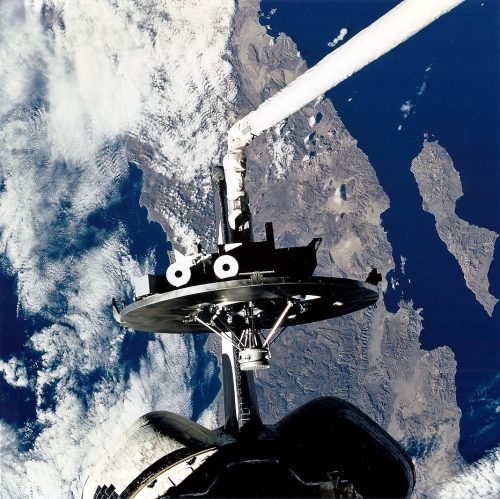
Within hours of deployment, the first of a planned seven processing “runs” laying down semiconducting films aboard the Wake Shield was underway, but problems were afoot. Early on 24 November, the shuttle crew was awakened to the news that ORFEUS-SPAS-2 was closing on the Wake Shield at a faster-than-anticipated rate. Pre-flight plans called for Cockrell and Rominger to execute up to two maneuvers per day, coupled with firings of the Wake Shield’s cold-gas thrusters, to maintain an intricate ballet between the three spacecraft and keep them all at appropriate distances from one another. Following lengthy tracking analyses, Mission Control decided that those separation distances were within limits, but Cockrell was instructed to retrieve the Wake Shield three hours early.
Fortunately, all seven films had been successfully processed by the evening of the 25th and the saucer-like satellite was grappled by the RMS at 7:01 p.m. EST. (A heater malfunction aboard Wake Shield, however, disrupted deposition of gallium during several experiment runs.) Throughout the rendezvous and capture, Columbia drew no closer than about 7 miles (10 km) from ORFEUS-SPAS-2, but for the Wake Shield it was not to be the end, for it had another important mission role to play. Late on 26 November, Jones again grappled the satellite for what turned out to be almost seven hours—twice as long as intended—of additional tests. The Wake Shield was oriented 45 degrees into the shuttle’s direction of travel to explore the usefulness of atomic oxygen in low-Earth orbit to grow aluminum oxide films. Finally, Jones berthed the satellite back onto its carrier in the payload bay at 1:53 a.m. EST on the 27th.
It was the final voyage of the Wake Shield. Originally, four flights were planned, with a last mission in mid-1998 to be financed by industrial partners. Capable of processing up to 300 thin films, an integration and test schedule for the fourth mission was approved, but NASA funding had run out by the end of 1997. An exclusive license was granted to Spacehab, Inc., to market the Wake Shield and, for a time, hope endured that a five-year version of the satellite might fly. Sadly, it was not to be. The emphasis of the shuttle program from the late 1990s upon the construction of the space station—coupled with delays after the loss of Columbia in February 2003—meant that the Wake Shield never flew again.
Yet even with the recapture and berthing of the satellite, Columbia’s long mission had still run for less than half of its scheduled duration. The remaining days of STS-80 were expected to feature the retrieval of ORFEUS-SPAS-2 and a pair of lengthy spacewalks by Jernigan and Jones, together with scientific and medical research. By the time Columbia finally returned to Earth on 7 December 1996, she would have secured an empirical record for the longest shuttle mission in history and triumphantly flown the shuttle’s then-oldest crew member. Those accomplishments, however, would be somewhat tempered by a series of unlikely problems which conspired against her would-be spacewalkers.
The author would like to express grateful appreciation to STS-80 Mission Specialist Tom Jones, who kindly shared his memories of this historic flight and contributed extensively to this article.
The second part of this article will appear tomorrow.
Want to keep up-to-date with all things space? Be sure to “Like” AmericaSpace on Facebook and follow us on Twitter: @AmericaSpace




